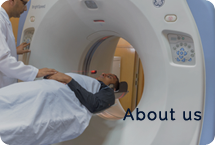- How is MRI different from a CT or X-ray?
-
Unlike X-ray exams, MRI does not use ionizing (X-ray) radiation. Instead, MR creates high quality images through the combination of a strong magnetic field and radio waves. MRI can detect certain diseases much earlier than other medical imaging techniques can, making it the diagnostic tool of choice for many physicians.
- What body parts can the MRI scanner evaluates?
-
Physicians use the MRI scanner to examine one part of the body at a time .The scanner can take pictures of one part of the body at a time .The scanner can take pictures of the head, neck, back, abdomen, pelvis, shoulder, elbow, knee, ankle, foot, blood vessels, and more.
- How long does the exam take?
-
Exams take approximately 25 minutes or more depending on the body part being scanned.
- Are there any special preparation/restrictions?
-
You only need to prepare for an MRI if you are going to have IV sedation or contrast (dye). in these conditions you should not eat or drink for several hours prior to your exam.
- Why is it so important to remove any metallic objects before I enter the scanning room?
-
You’ll need to remove all metal objects for safety reasons and because they cause artifacts to appear on the MRI image.
- What does the scanner look like?
-
The scanner is wide open from both ends, and well-ventilated through out. It also has a nurse call button and two -way intercom system so that you can communicate with the technologist at all times.
- Is there any risk?
-
MRI is very safe. There are no health risks associated with the magnetic field or the radio-waves used by the machine nor have any side effects been reported.
- May I have an MRI exam when I am pregnant or breastFeeding?
-
While an MRI scan has no known side effects, it is not recommended for pregnant women unless it is medically indicated. If you are breastfeeding and have contrast as part of your exam, please suspend nursing for 24 hours after the exam.







